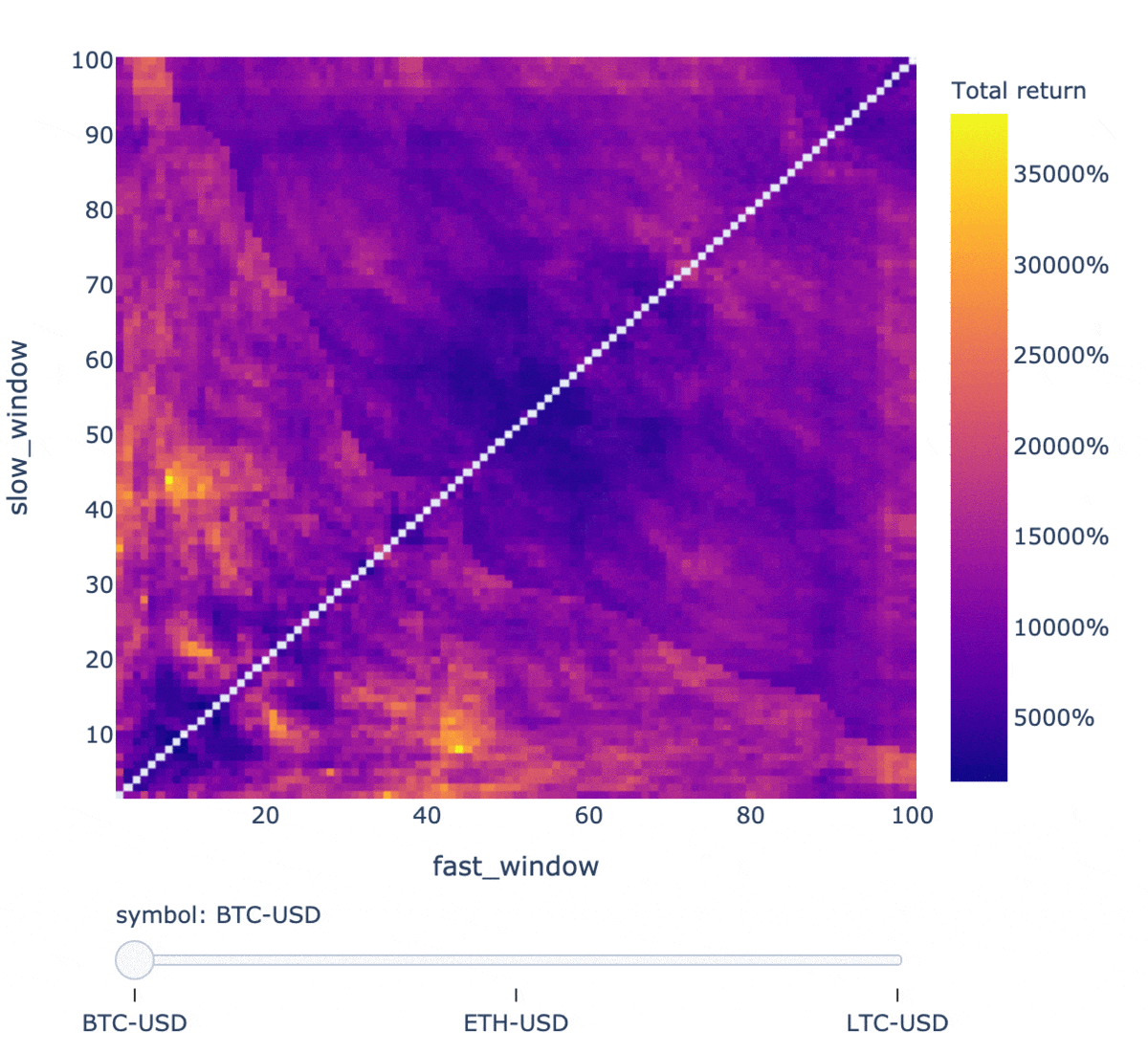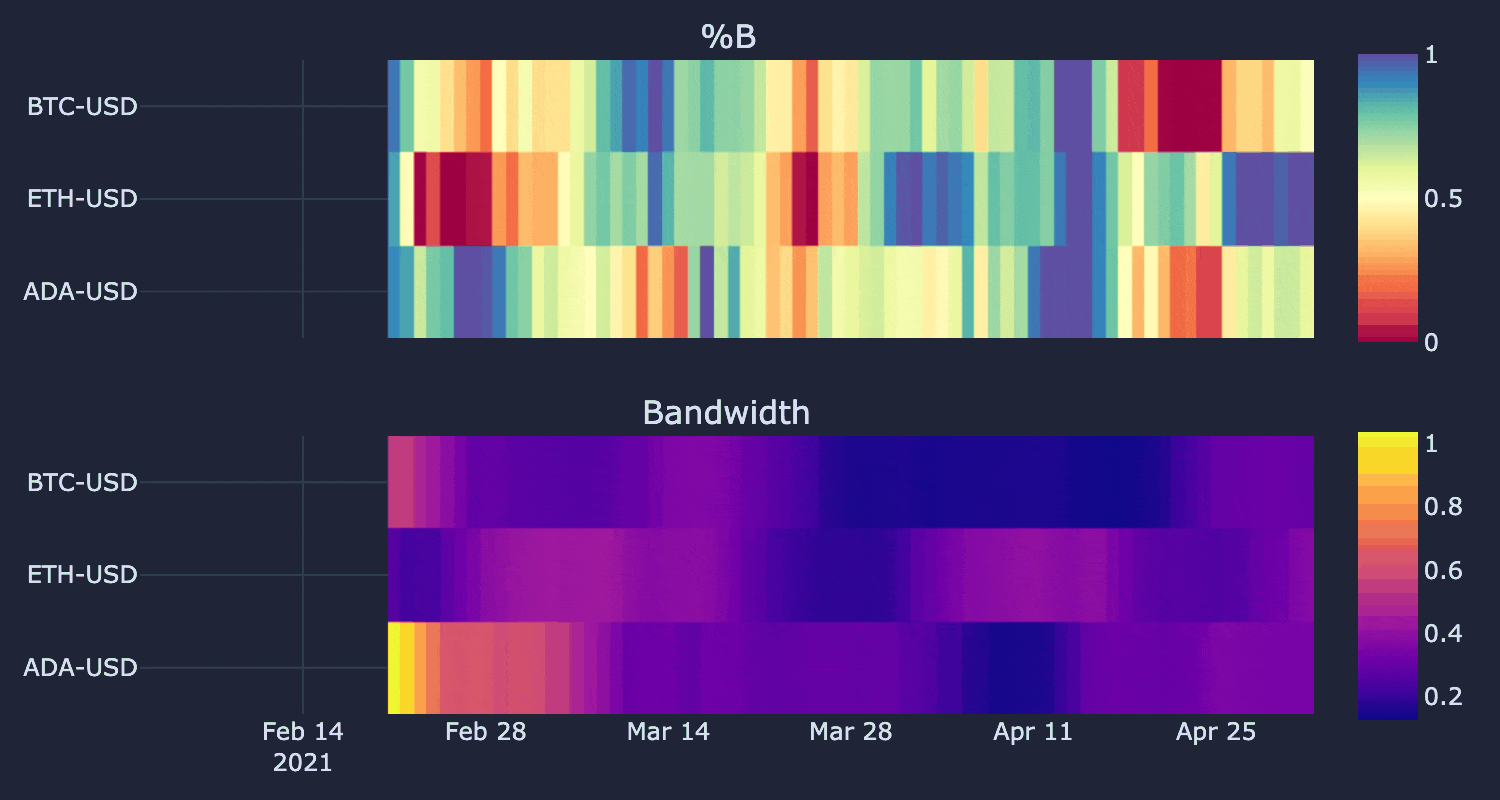Usage  ¶
¶
vectorbt allows you to easily backtest strategies with a couple of lines of Python code.
- Here is how much profit we would have made if we invested $100 into Bitcoin in 2014:
import vectorbt as vbt
price = vbt.YFData.download('BTC-USD').get('Close')
pf = vbt.Portfolio.from_holding(price, init_cash=100)
pf.total_profit()
8961.008555963961
- Buy whenever 10-day SMA crosses above 50-day SMA and sell when opposite:
fast_ma = vbt.MA.run(price, 10)
slow_ma = vbt.MA.run(price, 50)
entries = fast_ma.ma_crossed_above(slow_ma)
exits = fast_ma.ma_crossed_below(slow_ma)
pf = vbt.Portfolio.from_signals(price, entries, exits, init_cash=100)
pf.total_profit()
16423.251963801864
- Generate 1,000 strategies with random signals and test them on BTC and ETH:
import numpy as np
symbols = ["BTC-USD", "ETH-USD"]
price = vbt.YFData.download(symbols, missing_index='drop').get('Close')
n = np.random.randint(10, 101, size=1000).tolist()
pf = vbt.Portfolio.from_random_signals(price, n=n, init_cash=100, seed=42)
mean_expectancy = pf.trades.expectancy().groupby(['randnx_n', 'symbol']).mean()
fig = mean_expectancy.unstack().vbt.scatterplot(xaxis_title='randnx_n', yaxis_title='mean_expectancy')
fig.show()
- For fans of hyperparameter optimization: here is a snippet for testing 10,000 window combinations of a dual SMA crossover strategy on BTC, USD, and LTC:
symbols = ["BTC-USD", "ETH-USD", "LTC-USD"]
price = vbt.YFData.download(symbols, missing_index='drop').get('Close')
windows = np.arange(2, 101)
fast_ma, slow_ma = vbt.MA.run_combs(price, window=windows, r=2, short_names=['fast', 'slow'])
entries = fast_ma.ma_crossed_above(slow_ma)
exits = fast_ma.ma_crossed_below(slow_ma)
pf_kwargs = dict(size=np.inf, fees=0.001, freq='1D')
pf = vbt.Portfolio.from_signals(price, entries, exits, **pf_kwargs)
fig = pf.total_return().vbt.heatmap(
x_level='fast_window', y_level='slow_window', slider_level='symbol', symmetric=True,
trace_kwargs=dict(colorbar=dict(title='Total return', tickformat='%')))
fig.show()

Digging into each strategy configuration is as simple as indexing with pandas:
pf[(10, 20, 'ETH-USD')].stats()
Start 2015-08-07 00:00:00+00:00
End 2021-08-01 00:00:00+00:00
Period 2183 days 00:00:00
Start Value 100.0
End Value 620402.791485
Total Return [%] 620302.791485
Benchmark Return [%] 92987.961948
Max Gross Exposure [%] 100.0
Total Fees Paid 10991.676981
Max Drawdown [%] 70.734951
Max Drawdown Duration 760 days 00:00:00
Total Trades 54
Total Closed Trades 53
Total Open Trades 1
Open Trade PnL 67287.940601
Win Rate [%] 52.830189
Best Trade [%] 1075.803607
Worst Trade [%] -29.593414
Avg Winning Trade [%] 95.695343
Avg Losing Trade [%] -11.890246
Avg Winning Trade Duration 35 days 23:08:34.285714286
Avg Losing Trade Duration 8 days 00:00:00
Profit Factor 2.651143
Expectancy 10434.24247
Sharpe Ratio 2.041211
Calmar Ratio 4.6747
Omega Ratio 1.547013
Sortino Ratio 3.519894
Name: (10, 20, ETH-USD), dtype: object
The same for plotting:
pf[(10, 20, 'ETH-USD')].plot().show()
It's not all about backtesting - vectorbt can be used to facilitate financial data analysis and visualization.
- Let's generate a GIF that animates the %B and bandwidth of Bollinger Bands for different symbols:
symbols = ["BTC-USD", "ETH-USD", "ADA-USD"]
price = vbt.YFData.download(symbols, period='6mo', missing_index='drop').get('Close')
bbands = vbt.BBANDS.run(price)
def plot(index, bbands):
bbands = bbands.loc[index]
fig = vbt.make_subplots(
rows=2, cols=1, shared_xaxes=True, vertical_spacing=0.15,
subplot_titles=('%B', 'Bandwidth'))
fig.update_layout(template='vbt_dark', showlegend=False, width=750, height=400)
bbands.percent_b.vbt.ts_heatmap(
trace_kwargs=dict(zmin=0, zmid=0.5, zmax=1, colorscale='Spectral', colorbar=dict(
y=(fig.layout.yaxis.domain[0] + fig.layout.yaxis.domain[1]) / 2, len=0.5
)), add_trace_kwargs=dict(row=1, col=1), fig=fig)
bbands.bandwidth.vbt.ts_heatmap(
trace_kwargs=dict(colorbar=dict(
y=(fig.layout.yaxis2.domain[0] + fig.layout.yaxis2.domain[1]) / 2, len=0.5
)), add_trace_kwargs=dict(row=2, col=1), fig=fig)
return fig
vbt.save_animation('bbands.gif', bbands.wrapper.index, plot, bbands, delta=90, step=3, fps=3)
100%|██████████| 31/31 [00:21<00:00, 1.21it/s]

And this is just the tip of the iceberg of what's possible. Check out Resources to learn more.

